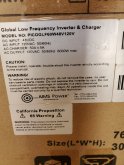almostalx
New Member
- Joined
- May 8, 2020
- Messages
- 13
Hi there!
I'm finalizing a van build and I just realized that I made a mistake. I ran all the wires for my appliances, but I forgot about the AC outlet ground. Normally I would've used a 12/3 wire from the inverter to the 2 outlets that I have, but when I did my wiring I forgot about the ground and used a 12/2 wire. My walls are closed now and it would be a real pain to re-open and change the wires for those 2 outlets. It might be a dumb question, but can I ground the 2 outlets to the van chassis and call it a day? Or do I really need to ground the outlets in the inverter?
Thanks for the tip!
I'm finalizing a van build and I just realized that I made a mistake. I ran all the wires for my appliances, but I forgot about the AC outlet ground. Normally I would've used a 12/3 wire from the inverter to the 2 outlets that I have, but when I did my wiring I forgot about the ground and used a 12/2 wire. My walls are closed now and it would be a real pain to re-open and change the wires for those 2 outlets. It might be a dumb question, but can I ground the 2 outlets to the van chassis and call it a day? Or do I really need to ground the outlets in the inverter?
Thanks for the tip!



